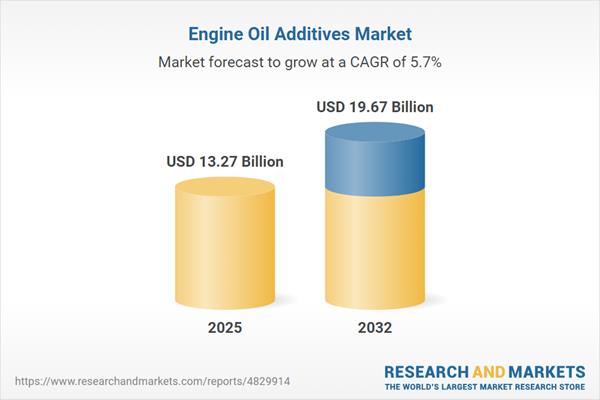Speak directly to the analyst to clarify any post sales queries you may have.
The engine oil additives market continues to evolve rapidly, driven by increasing regulatory requirements, advanced engine designs, and strategic innovation among leading suppliers. Senior decision-makers are reassessing procurement and product development approaches to maintain reliability, efficiency, and compliance in an increasingly complex landscape.
Market Snapshot: Engine Oil Additives Market Growth and Outlook
The engine oil additives market grew from USD 12.58 billion in 2024 to USD 13.27 billion in 2025. It is projected to grow at a CAGR of 5.73%, reaching USD 19.67 billion by 2032. This upward trajectory highlights sustained investment from manufacturers and growing demand for high-performance lubricants in both established and developing regions. Increasing adoption of advanced powertrain technologies, along with upgrades in aftermarket servicing and heightened emission control measures, are key market drivers shaping competitive dynamics.
Scope & Segmentation of the Engine Oil Additives Market
This market report provides detailed segmentation to support deeper analysis and strategic planning. Key segmentation areas include:
- Additive Types: Anti-wear agents, antioxidants, corrosion inhibitors, detergents, dispersants, foam inhibitors, friction modifiers, pour point depressants, viscosity index improvers
- Functionality: Emission control additives, performance enhancing additives, protective additives
- Sales Channels: Offline, online
- Applications: Automotive, industrial equipment, marine & aerospace
- Geographies: Americas, Europe, Middle East & Africa, Asia-Pacific
- Key Companies: Afton Chemical Limited, AMSOIL Inc., Baker Hughes Company, BASF SE, Chevron Corporation, Dorf-Ketal Chemicals India Limited, Eni SpA, Evonik Industries AG, Exxon Mobil Corporation, Ganesh Benzoplast Limited, Illinois Tool Works Inc., Infineum International Limited, Jinzhou Kangtai Lubricant Additives CO., Ltd., Kemipex, Lanxess AG, Lucas Oil Products, Inc., MidContinental Chemical Company, Inc., Petroliam Nasional Berhad, R.T. Vanderbilt Holding Company, Inc., The Lubrizol Corporation, TotalEnergies SE, Valvoline Inc., Wuxi South Petroleum Additive Co., Ltd.
- Regional Markets: North America (United States, Canada, Mexico), Latin America (Brazil, Argentina, Chile, Colombia, Peru), Europe (United Kingdom, Germany, France, Russia, Italy, Spain, Netherlands, Sweden, Poland, Switzerland), Middle East (United Arab Emirates, Saudi Arabia, Qatar, Turkey, Israel), Africa (South Africa, Nigeria, Egypt, Kenya), Asia-Pacific (China, India, Japan, Australia, South Korea, Indonesia, Thailand, Malaysia, Singapore, Taiwan)
Key Takeaways for Senior Decision-Makers
- Engine oil additives are critical in prolonging engine life, enhancing fuel efficiency, and supporting compliance with modern emission and durability standards.
- Innovation is focused on expanding additive packages tailored to hybrid, high-performance diesel, and electrified powertrains, supporting shifting mobility trends and advanced engine operating conditions.
- Suppliers are leveraging digital oil monitoring and predictive technologies to add value for end-users and optimize additive dosing and maintenance cycles.
- Sustainability, including bio-based additives and reduction of phosphorus content, is increasingly important for future product portfolios and regulatory alignment.
- Online distribution channels and digital procurement platforms are streamlining supply chains and expanding market access, particularly in developing regions.
- Competition is intensifying around proprietary antioxidant technologies and strategic geographic expansion via mergers, acquisitions, and regional production hubs.
Impact of 2025 United States Tariffs on Engine Oil Additives
Upcoming tariffs in the United States are significantly impacting material costs and prompting a reassessment of global supply chain strategies. Companies are exploring alternative sourcing, adapting formulations, and considering local manufacturing footprints to reduce exposure to cost volatility. Vertical integration and regional partnerships are among the strategies adopted to maintain resilience and competitiveness while navigating an uncertain trade environment.
Methodology & Data Sources
This report integrates comprehensive secondary research from technical publications, patent filings, and regulatory documentation with primary interviews from industry stakeholders such as formulators, engineers, and procurement specialists. Final insights are validated through analytical triangulation of financial records, trade statistics, and supplier data to ensure reliability and actionable intelligence.
Why This Report Matters
- Provides a strategic foundation for aligning R&D pipelines with regulatory and market changes in engine oil additives.
- Supports procurement, manufacturing, and marketing decisions by clarifying competitive positioning and regional demand drivers.
- Enables senior leaders to benchmark innovation strategies and prepare for evolving tariff and supply chain challenges.
Conclusion
Senior executives can draw on this report’s insights to shape growth strategies, manage risk, and drive product innovation in the global engine oil additives market. Proactive investment, agile adaptation, and sustainability will remain key to long-term industry leadership.
Additional Product Information:
- Purchase of this report includes 1 year online access with quarterly updates.
- This report can be updated on request. Please contact our Customer Experience team using the Ask a Question widget on our website.
Table of Contents
3. Executive Summary
4. Market Overview
7. Cumulative Impact of Artificial Intelligence 2025
Companies Mentioned
The companies profiled in this Engine Oil Additives market report include:- Afton Chemical Limited
- AMSOIL Inc.
- Baker Hughes Company
- BASF SE
- Chevron Corporation
- Dorf-Ketal Chemicals India Limited
- Eni SpA
- Evonik Industries AG
- Exxon Mobil Corporation
- Ganesh Benzoplast Limited
- Illinois Tool Works Inc.
- Infineum International Limited
- Jinzhou Kangtai Lubricant Additives CO., Ltd.
- Kemipex
- Lanxess AG
- Lucas Oil Products, Inc.
- MidContinental Chemical Company, Inc.
- Petroliam Nasional Berhad
- R.T. Vanderbilt Holding Company, Inc.
- The Lubrizol Corporation
- TotalEnergies SE
- Valvoline Inc.
- Wuxi South Petroleum Additive Co., Ltd.
Table Information
| Report Attribute | Details |
|---|---|
| No. of Pages | 196 |
| Published | November 2025 |
| Forecast Period | 2025 - 2032 |
| Estimated Market Value ( USD | $ 13.27 Billion |
| Forecasted Market Value ( USD | $ 19.67 Billion |
| Compound Annual Growth Rate | 5.7% |
| Regions Covered | Global |
| No. of Companies Mentioned | 24 |









